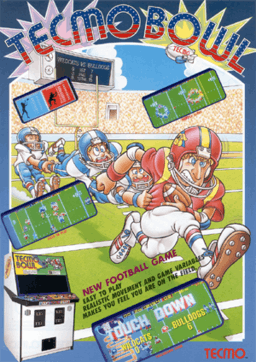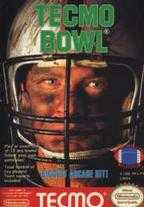Tecmo Bowl
| Tecmo Bowl | |
|---|---|
 European arcade flyer of Tecmo Bowl | |
| Developer(s) | Tecmo Sculptured Software (Game Boy) |
| Publisher(s) | Tecmo |
| Series | Tecmo Bowl |
| Platform(s) | Arcade, Nintendo Entertainment System, PlayChoice-10, Game Boy, Mobile phone, Virtual Console |
| Release date(s) | Arcade
NES (Wii)
NES (Nintendo 3DS)
|
| Mode(s) | Single-player, multiplayer |
Tecmo Bowl (テクモボウル tekumo Bōru) is an (American) football arcade game developed and released in 1988 by Tecmo.[1] While moderately successful in the arcades, the game became and remained widely popular and remembered when it was ported to the Nintendo Entertainment System in 1989. The NES version was the first console game to feature real NFL players. Although LJN's NFL was the first NES game to feature NFL team names, it was not as successful as Tecmo Bowl. Because of this, and combined with the scarcity of the arcade version, the NES version eclipsed its arcade counterpart in popularity. The NES version was ported to mobile phones in 2004 and the North American Virtual Console on March 12, 2007 for the Wii and on September 12, 2013 for the Nintendo 3DS. The arcade version for the Wii Virtual Console came out in North America on August 3, 2009 and Japan on September 29, 2009.
Gameplay
The original arcade version was distinguished by a large two-monitor cabinet, support for up to four players, and the ability to break tackles. Only two fictional teams can be chosen: the Wildcats and the Bulldogs.
The NES version allowed two players rather than four from the arcade version. The player could choose between three modes: one-player, two-player, and coach. In one-player mode, the player picked a football team and played against the computer. After every game that the player wins, the computer picked another team to play as, and the player stays with his/her original choice. In the two-player and coach modes, the player and another human will play one game but the players only chose the plays in the coach mode (which cannot be done in the arcade version).
In both versions, the playbook consisted of only four offensive plays. When on defense, a player selected which play thought to be the one that the offense would select; if chosen correctly, it would result in a collapse of the offensive line and well-covered receivers.
Though more realistic than other American football games of the era, like Irem's 10 Yard Fight, Tecmo Bowl had quirks. For instance, almost any pass thrown to a covered receiver resulted in an interception, and it was unrealistically easy for some teams to block field goals and extra points. Lawrence Taylor of New York and Dexter Manley of Washington could block any field goal or extra point simply by selecting them and running down the line and through the long snapper. Also, San Francisco and Miami each had a pass play that was nearly unstoppable against any defense, with proper timing: the slot receiver curl route from the shotgun. Human defenses could stop this by double teaming the curl receiver with the defensive end. [citation needed]
Despite featuring the names and statistics of real NFL players from the 1988 season, the gameplay limited how closely the video game players mimicked real life players. Unlike the NFL, The arcade version only allowed ten players for each team on the field at a time and the NES version only consisted of nine on each side. For the most part the gameplay was a form of keep away. The offensive player with the ball tried to avoid the defenders, the defenders tried to avoid blockers and catch the player with the ball (Players could sometimes break free of blocks or tackles). This made speed the crucial attribute, and other characteristics of NFL players such as strength and technique were largely ignored. Regardless of position or the speed of the real life player, better players with better stats were faster, lesser players were slower. So top defensive linemen, who tend to be larger and slower in real life, were faster than the typical defensive backs, running backs, and receivers. The exceptions were punters and kickers whose primary attribute was kick distance, and quarterbacks whose primary attribute was arm strength/pass speed. The QBs with the best stats throw the hardest, fastest passes even if the real life player doesn't have the strongest arm.
Teams
Tecmo Bowl contains twelve teams, each equipped with four plays. Most teams have two running plays and two passing plays. The exceptions are San Francisco and Miami, who have three passing plays and one running play.
Tecmo was not able to get the NFL's consent to use real team names. As a result, the teams in the game are identified solely by their home city or state. However, each roster mimics that of the NFL team based out of the same city or state. Tecmo Bowl only used players from twelve of the best and most popular teams.
The teams mimicked in the game are Indianapolis, Miami, Cleveland, Denver, Seattle, Los Angeles (Raiders), Washington, San Francisco, Dallas, New York (Giants), Chicago, and Minnesota.
| AFC | NFC |
|---|---|
| Los Angeles (Raiders) | Washington |
| Indianapolis | San Francisco |
| Miami | Dallas |
| Denver | New York (Giants) |
| Seattle | Chicago |
| Cleveland | Minnesota |
Each team had a different level of effectiveness based on its personnel and play selection. Chicago (with Walter Payton / and Mike Singletary) and San Francisco (Joe Montana and Ronnie Lott) were two of the top teams because they had top talent on both offense and defense. Los Angeles had the fastest offensive player in the game (Bo Jackson) but only one running play which utilized him (Marcus Allen was used in the second running play). New York had a middling offense but the fastest defender in the game, Lawrence Taylor. Minnesota is among the worst teams in the game with the unfortunate combination of average talent and a terrible playbook which includes an extremely ineffective wide receiver reverse run.
No players featured in the original Tecmo Bowl are still active in the NFL after the retirement of punter Sean Landeta on March 6, 2008. The last player to leave the NFL who was active at the time of the game's release, yet played for a team not included in the game was kicker Morten Andersen, who retired not long after on December 8, 2008.
There were two NES versions of the game released in the U.S. The first release is easily identified by its black and gold seal of quality and the second version by its white and gold seal. The original Tecmo Bowl for the NES featured Eric Dickerson as running back and Albert Bentley as kick returner for Indianapolis. A later version that was released had Albert Bentley as running back and Clarence Verdin as kick returner, instead. A year later, the Japanese NES Famicom version of Tecmo Bowl had many roster changes that were included in the game to reflect the year it was released.
Ports and related releases

- 1989: NES
- 1990: Famicom
- 1991: Game Boy (developed by Sculptured Software)
- 2004: mobile phones
- 2007: Wii Virtual Console (NES version)
- 2009: Wii Virtual Console (Arcade version)
- 2013: 3DS Virtual Console (NES version)
The 2007 and 2013 Virtual Console releases is a modified version of the game without the NFLPA license, since EA owns exclusive rights to it; thus, the players are represented only by number and not by name.[2] The original arcade version was featured in Tecmo Classic Arcade for the Xbox.
Tecmo Bowl also has two updated versions. On November 18, 2008, a first one was released for the Nintendo DS, titled Tecmo Bowl: Kickoff.[3] In 2010, a second one was released for the Xbox 360 and PlayStation 3 called Tecmo Bowl Throwback.[4]
See also
References
- ↑ "Tecmo Bowl". The International Arcade Museum. Retrieved 06OCT2013.
- ↑ "Tecmo Bowl VC Review". IGN. March 13, 2007.
- ↑ Harris, Craig (2008-05-01). "Tecmo Bowl Returns". IGN.
- ↑ "ESRB Rating, Tecmo Bowl Throwback".
External links
- "TecmoBowl-vs-RBI" An indepth look at strategy and player attributes for Tecmo Bowl and RBI baseball
- Tecmo Bowl at the Killer List of Videogames
- Tecmo Bowl at MAWS
- Tecmo Bowl at MobyGames
- "The Greatest Games of All Time", GameSpot